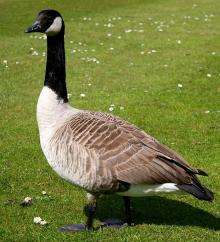December 22, 2010 report
Delayed legacy of invasive species

(PhysOrg.com) -- A team of researchers in Europe has urged governments to introduce tougher controls of all international trade that could result in the introduction of non-native species. They say the full impact of alien species may not be evident for decades because they may co-exist with native species for a long time before becoming invasive.
Governments everywhere have begun to realize the undesirable effects of introducing non-native species, but many of the species causing problems today were introduced many decades ago. To study the problem the researchers, from a range of agencies and universities in Austria, the Czech Republic, Germany, Italy, and elsewhere, looked at data on over 3,300 invasive species in 28 European countries. The species were representatives of 10 taxonomic groups and included mammals, amphibians, birds, reptiles, fish, plants, insects, and fungi, and included species such as Canadian Geese, American Ragweed, and Japanese Deer.
Individual countries in Europe have not seen the same rate of development and population growth in the last century, and the differences allowed the researchers to determine if the lag times between introduction of species and their establishment were related to socioeconomic factors. What they found was that the current numbers of alien species now established in the wild are more closely related to socioeconomic indicators such as population density, per capita gross domestic product (GDP) and level of exports of the year 1900 than to those of 2000.
The researchers also found it could take decades before it became clear which species would become disruptive. The association with 1900 socioeconomic indicators was less prominent in birds, reptiles and insects that are able to disperse and colonize new areas more rapidly, but for the majority of groups the results suggested a “considerable historical legacy.”
The authors speculate that the level of socioeconomic activity in a country could affect the success of an alien species through deliberate introduction efforts, but more importantly through expansions of roads and human population centers, and the conversion of natural habitats into agricultural land, which has already been shown to foster the spread and naturalization of alien species. Per capita GDP may correlate with rates of introduction.
The results suggest that the effects on invasive species of the current high levels of socioeconomic activity will not be completely felt for several decades.
The researchers described the delay as an "invasion debt" and said that even with existing trade and biosecurity regulations, "the seeds of future invasion problems have already been sown." They recommended introduced species that were currently not causing problems but had been seen to be invasive elsewhere should be more strictly controlled.
The scientists warned further introductions of alien species could have greater impacts on biodiversity and the economy than previously thought. They also said the threat from invasive species is among the major causes of biodiversity loss, along with habitat fragmentation and destruction. The problems are estimated to be costing $16 billion a year in Europe.
The paper is published online in the US Proceedings of the National Academy of Sciences (PNAS).
More information: Socioeconomic legacy yields an invasion debt, Proceedings of the National Academy of Sciences Published online before print December 20, 2010, doi:10.1073/pnas.1011728108
© 2010 PhysOrg.com















